ignition MINI Hardtop 2 Door 2005 User Guide
[x] Cancel search | Manufacturer: MINI, Model Year: 2005, Model line: Hardtop 2 Door, Model: MINI Hardtop 2 Door 2005Pages: 165, PDF Size: 2.32 MB
Page 39 of 165
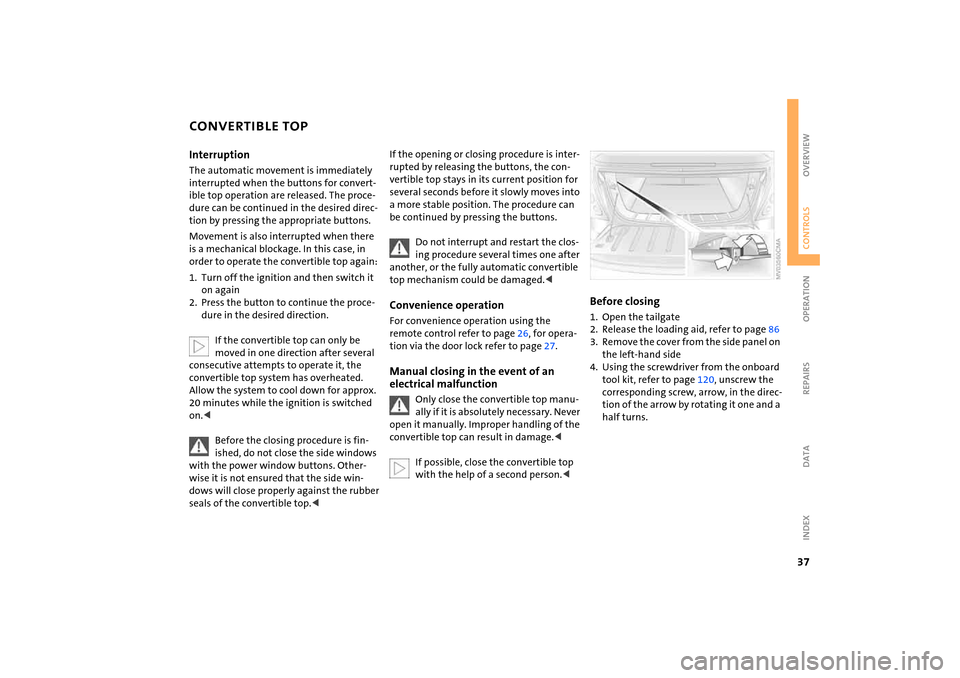
37
OVERVIEW REPAIRS OPERATIONCONTROLS DATA INDEX
CONVERTIBLE TOPInterruptionThe automatic movement is immediately
interrupted when the buttons for convert
-
ible top operation are released. The proce
-
dure can be continued in the desired direc
-
tion by pressing the appropriate buttons.Movement is also interrupted when there
is a mechanical blockage. In this case, in
order to operate the convertible top again:1. Turn off the ignition and then switch it
on again2. Press the button to continue the proce
-
dure in the desired direction.
If the convertible top can only be moved in one direction after several
consecutive attempts to operate it, the
convertible top system has overheated.
Allow the system to cool down for approx.
20
minutes while the ignition is switched
on.<
Before the closing procedure is fin
-
ished, do not close the side windows
with the power window buttons. Other
-
wise it is not ensured that the side win
-
dows will close properly against the rubber
seals of the convertible top.<
If the opening or closing procedure is inter
-
rupted by releasing the buttons, the con
-
vertible top stays in its current position for
several seconds before it slowly moves into
a more stable position. The procedure can
be continued by pressing the buttons.
Do not interrupt and restart the clos
-
ing procedure several times one after
another, or the fully automatic convertible
top mechanism could be damaged.<
Convenience operationFor convenience operation using the
remote control refer to page
26, for opera
-
tion via the door lock refer to page
27.
Manual closing in the event of an
electrical malfunction
Only close the convertible top manu
-
ally if it is absolutely necessary. Never
open it manually. Improper handling of the
convertible top can result in damage.
86
3. Remove the cover from the side panel on
the left-hand side4. Using the screwdriver from the onboard
tool kit, refer to page
120
, unscrew the
corresponding screw, arrow, in the direc
-
tion of the arrow by rotating it one and a
half turns.
Page 43 of 165
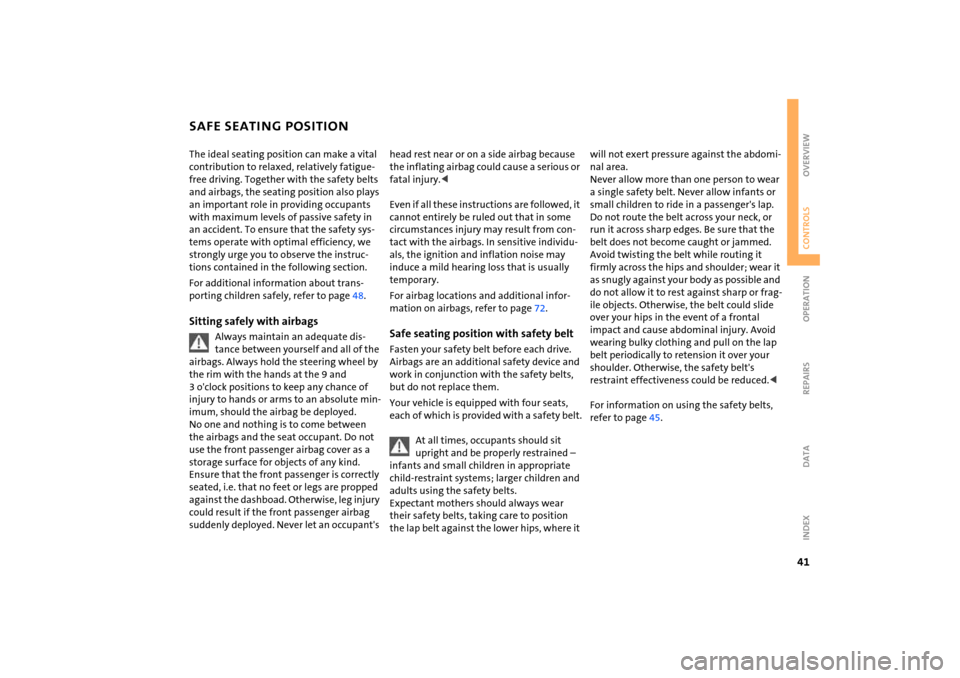
41
OVERVIEW REPAIRS OPERATIONCONTROLS DATA INDEX
SAFE SEATING POSITIONThe ideal seating position can make a vital
contribution to relaxed, relatively fatigue-
free driving. Together with the safety belts
and airbags, the seating position also plays
an important role in providing occupants
with maximum levels of passive safety in
an accident. To ensure that the safety sys
-
tems operate with optimal efficiency, we
strongly urge you to observe the instruc
-
tions contained in the following section.For additional information about trans
-
porting children safely, refer to page
48.
Sitting safely with airbags
Always maintain an adequate dis
-
tance between yourself and all of the
airbags. Always hold the steering wheel by
the rim with the hands at the 9 and
3
o'clock positions to keep any chance of
injury to hands or arms to an absolute min
-
imum, should the airbag be deployed.
No one and nothing is to come between
the airbags and the seat occupant. Do not
use the front passenger airbag cover as a
storage surface for objects of any kind.
Ensure that the front passenger is correctly
seated, i.e. that no feet or legs are propped
against the dashboad. Otherwise, leg injury
could result if the front passenger airbag
suddenly deployed. Never let an occupant's
head rest near or on a side airbag because
the inflating airbag could cause a serious or
fatal injury.
circumstances injury may result from con
-
tact with the airbags. In sensitive individu
-
als, the ignition and inflation noise may
induce a mild hearing loss that is usually
temporary. For airbag locations and additional infor
-
mation on airbags, refer to page
72.
Safe seating position with safety belt Fasten your safety belt before each drive.
Airbags are an additional safety device and
work in conjunction with the safety belts,
but do not replace them.Your vehicle is equipped with four seats,
each of which is provided with a safety belt.
At all times, occupants should sit upright and be properly restrained –
infants and small children in appropriate
child-restraint systems; larger children and
adults using the safety belts.
Expectant mothers should always wear
their safety belts, taking care to position
the lap belt against the lower hips, where it
will not exert pressure against the abdomi
-
nal area.
Never allow more than one person to wear
a single safety belt. Never allow infants or
small children to ride in a passenger's lap.
Do not route the belt across your neck, or
run it across sharp edges. Be sure that the
belt does not become caught or jammed.
Avoid twisting the belt while routing it
firmly across the hips and shoulder; wear it
as snugly against your body as possible and
do not allow it to rest against sharp or frag
-
ile objects. Otherwise, the belt could slide
over your hips in the event of a frontal
impact and cause abdominal injury. Avoid
wearing bulky clothing and pull on the lap
belt periodically to retension it over your
shoulder. Otherwise, the safety belt's
restraint effectiveness could be reduced.
45.
Page 48 of 165
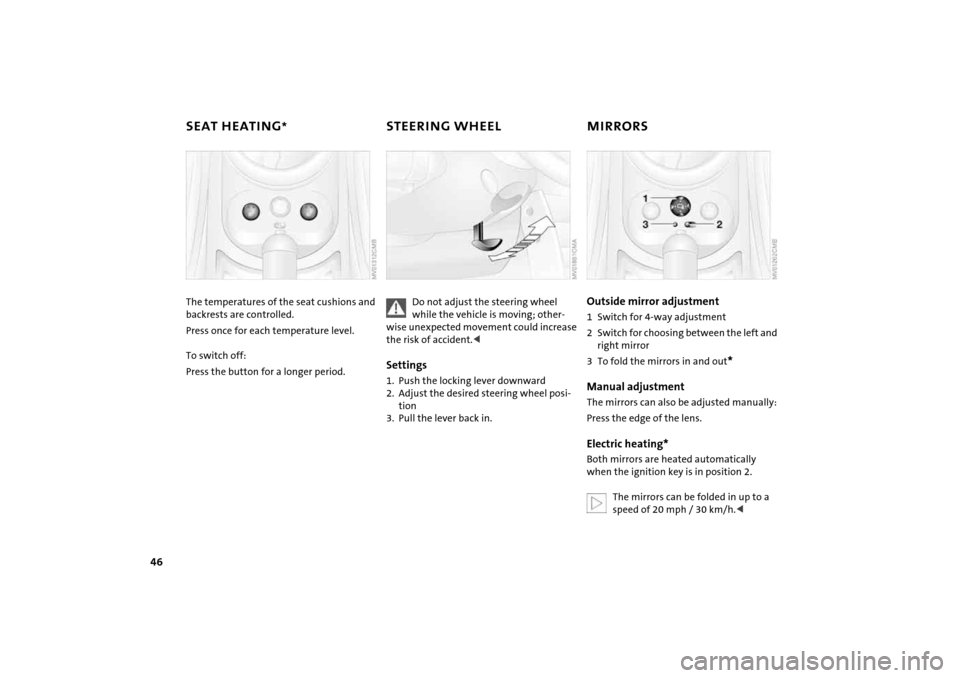
46
SEAT HEATING
*
STEERING WHEEL
MIRRORS
The temperatures of the seat cushions and backrests are controlled.Press once for each temperature level.To switch off:Press the button for a longer period.
Do not adjust the steering wheel while the vehicle is moving; other
-
wise unexpected movement could increase
the risk of accident.
tion
3. Pull the lever back in.
Outside mirror adjustment1 Switch for 4-way adjustment 2 Switch for choosing between the left and
right mirror 3 To fold the mirrors in and out
*
Manual adjustmentThe mirrors can also be adjusted manually: Press the edge of the lens.Electric heating* Both mirrors are heated automatically
when the ignition key is in position
2.
The mirrors can be folded in up to a speed of 20
mph
/ 30 km/h.<
Page 49 of 165
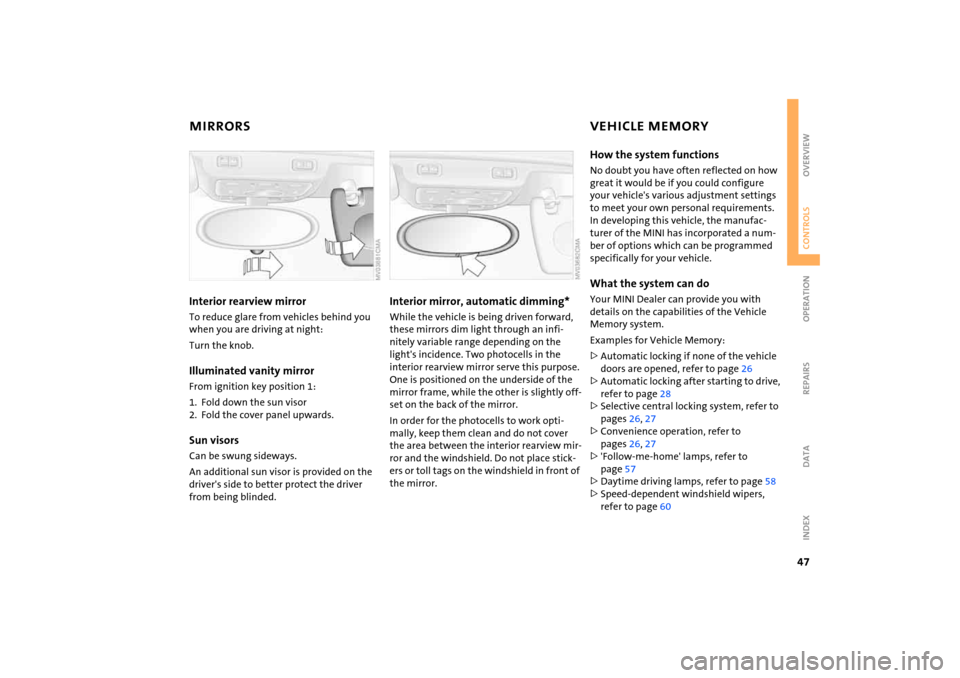
47
OVERVIEW REPAIRS OPERATIONCONTROLS DATA INDEX
MIRRORS
VEHICLE MEMORY
Interior rearview mirror To reduce glare from vehicles behind you
when you are driving at night:Turn the knob.Illuminated vanity mirror From ignition key position
1:
1. Fold down the sun visor2. Fold the cover panel upwards.Sun visorsCan be swung sideways.An additional sun visor is provided on the
driver's side to better protect the driver
from being blinded.
Interior mirror, automatic dimming* While the vehicle is being driven forward,
these mirrors dim light through an infi
-
nitely variable range depending on the
light's incidence. Two photocells in the
interior rearview mirror serve this purpose.
One is positioned on the underside of the
mirror frame, while the other is slightly off
-
set on the back of the mirror.In order for the photocells to work opti
-
mally, keep them clean and do not cover
the area between the interior rearview mir
-
ror and the windshield. Do not place stick
-
ers or toll tags on the windshield in front of
the mirror.
How the system functionsNo doubt you have often reflected on how
great it would be if you could configure
your vehicle's various adjustment settings
to meet your own personal requirements.
In developing this vehicle, the manufac
-
turer of the MINI has incorporated a num
-
ber of options which can be programmed
specifically for your vehicle. What the system can doYour MINI Dealer can provide you with
details on the capabilities of the Vehicle
Memory system.Examples for Vehicle Memory:>Automatic locking if none of the vehicle
doors are opened, refer to page
26
>Automatic locking after starting to drive,
refer to page
28
>Selective central locking system, refer to
pages
26, 27
>Convenience operation, refer to
pages
26, 27
>'Follow-me-home' lamps, refer to
page
57
>Daytime driving lamps, refer to page
58
>Speed-dependent windshield wipers,
refer to page
60
Page 53 of 165

51
OVERVIEW REPAIRS OPERATIONCONTROLS DATA INDEX
IGNITION LOCK
STARTING THE ENGINE
0 Steering locked
The key can be inserted or removed in this
position only.To lock the steering:1. Remove the key2. Turn the steering wheel slightly to the
left or right until the lock engages.A sound alarm goes off if the key remains in
the ignition after opening the driver's door.Interlock Vehicles with Continuously Variable auto
-
matic Transmission (CVT):
The ignition key cannot be turned to
position
0 and removed until the selector
lever is in position
P.
1 Steering unlocked
Individual electrical accessories are ready
for operation.You will find that it is often easier to turn
the ignition key from position
0 to
position
1 when you move the steering
wheel slightly to help disengage the lock.
2 Ignition switched on
All electrical accessories are ready for oper
-
ation.3 Starting the engine
Vehicles with manual transmission:
Step on the clutch when starting the
vehicle. A lockout prevents the engine from
starting if the clutch is not depressed.<
Do not allow the engine to run in enclosed spaces. Breathing the nox
-
ious exhaust gases can lead to uncon
-
sciousness and death. The exhaust gases
contain carbon monoxide, an odorless and
colorless, but highly toxic gas.
Do not leave the vehicle unattended with
the engine running. This is a safety hazard.
When driving, standing at idle, and parking
the vehicle, take care to avoid contact
between the hot exhaust system and flam
-
mable materials, e.g. hay, grass, leaves, etc.
Such contact could lead to a fire resulting in
serious personal injury and property dam
-
age.
vehicle at a standstill. Move off immedi
-
ately at a moderate engine speed.
Page 54 of 165
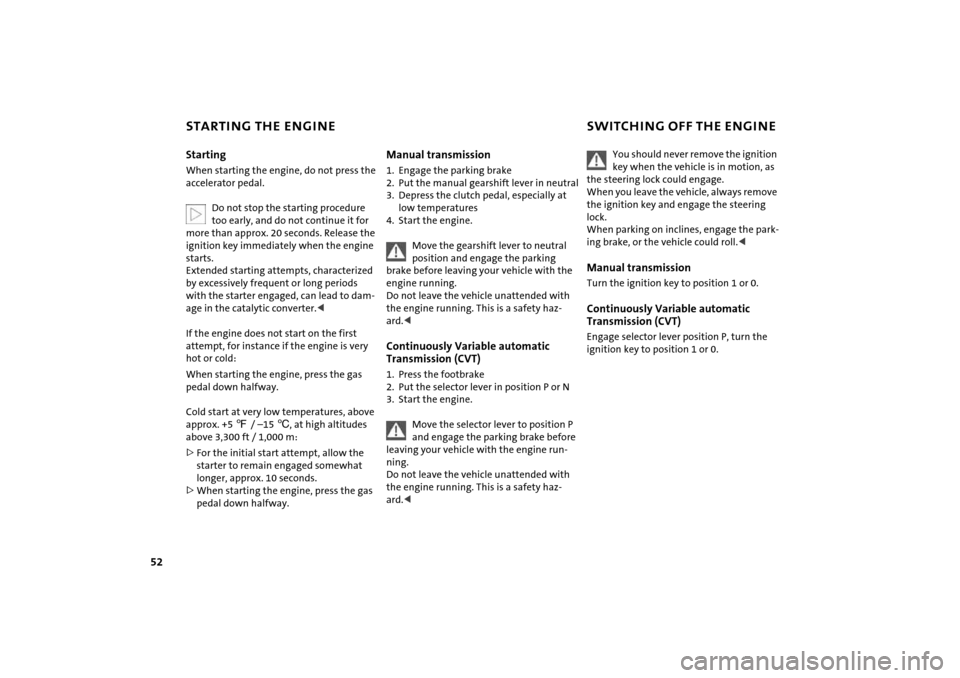
52
STARTING THE ENGINE
SWITCHING OFF THE ENGINE
StartingWhen starting the engine, do not press the
accelerator pedal.
Do not stop the starting procedure too early, and do not continue it for
more than approx. 20
seconds. Release the
ignition key immediately when the engine
starts.
Extended starting attempts, characterized
by excessively frequent or long periods
with the starter engaged, can lead to dam
-
age in the catalytic converter.
hot or cold:When starting the engine, press the gas
pedal down halfway.Cold start at very low temperatures, above
approx. +5
7
/ –15
6, at high altitudes
above 3,300
ft / 1,000 m:
>For the initial start attempt, allow the
starter to remain engaged somewhat
longer, approx. 10
seconds.
>When starting the engine, press the gas
pedal down halfway.
Manual transmission1. Engage the parking brake2. Put the manual gearshift lever in neutral3. Depress the clutch pedal, especially at
low temperatures4. Start the engine.
Move the gearshift lever to neutral position and engage the parking
brake before leaving your vehicle with the
engine running.
Do not leave the vehicle unattended with
the engine running. This is a safety haz
-
ard.
P or N
3. Start the engine.
Move the selector lever to position
P
and engage the parking brake before
leaving your vehicle with the engine run
-
ning.
Do not leave the vehicle unattended with
the engine running. This is a safety haz
-
ard.<
You should never remove the ignition key when the vehicle is in motion, as
the steering lock could engage.
When you leave the vehicle, always remove
the ignition key and engage the steering
lock.
When parking on inclines, engage the park
-
ing brake, or the vehicle could roll.
Continuously Variable automatic
Transmission (CVT)Engage selector lever position
P, turn the
ignition key to position
1 or 0.
Page 55 of 165
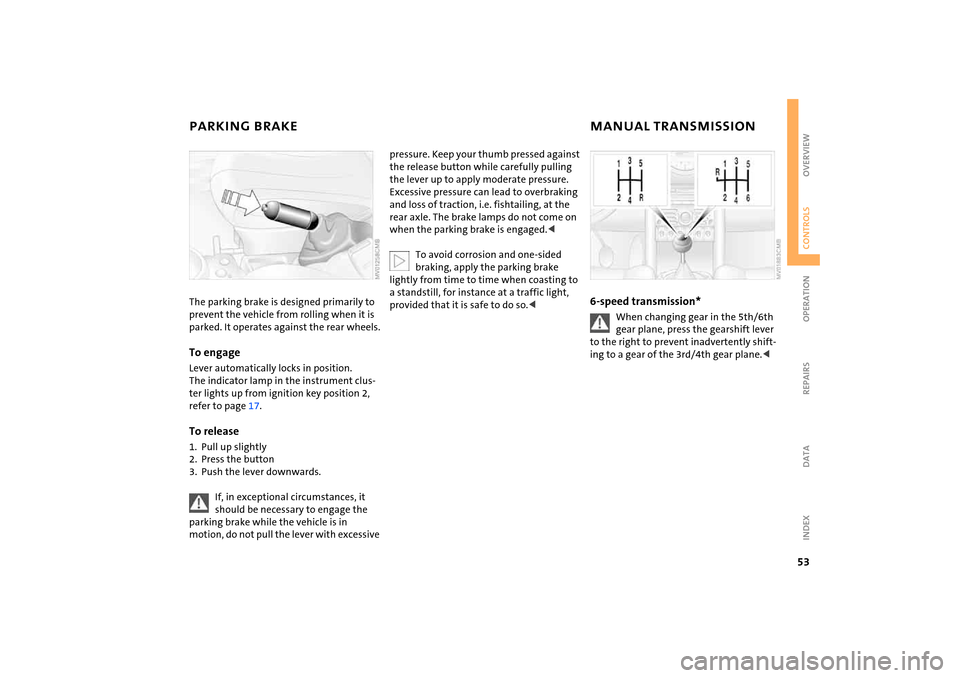
53
OVERVIEW REPAIRS OPERATIONCONTROLS DATA INDEX
PARKING BRAKE
MANUAL TRANSMISSION
The parking brake is designed primarily to prevent the vehicle from rolling when it is
parked. It operates against the rear wheels.To engageLever automatically locks in position.
The indicator lamp in the instrument clus
-
ter lights up from ignition key position
2,
refer to page
17.
To release1. Pull up slightly2. Press the button3. Push the lever downwards.
If, in exceptional circumstances, it should be necessary to engage the
parking brake while the vehicle is in
motion, do not pull the lever with excessive
pressure. Keep your thumb pressed against
the release button while carefully pulling
the lever up to apply moderate pressure.
Excessive pressure can lead to overbraking
and loss of traction, i.e. fishtailing, at the
rear axle. The brake lamps do not come on
when the parking brake is engaged.<
To avoid corrosion and one-sided braking, apply the parking brake
lightly from time to time when coasting to
a standstill, for instance at a traffic light,
provided that it is safe to do so.<
6-speed transmission*
When changing gear in the 5th/6th gear plane, press the gearshift lever
to the right to prevent inadvertently shift
-
ing to a gear of the
3rd/4th gear plane.<
Page 56 of 165
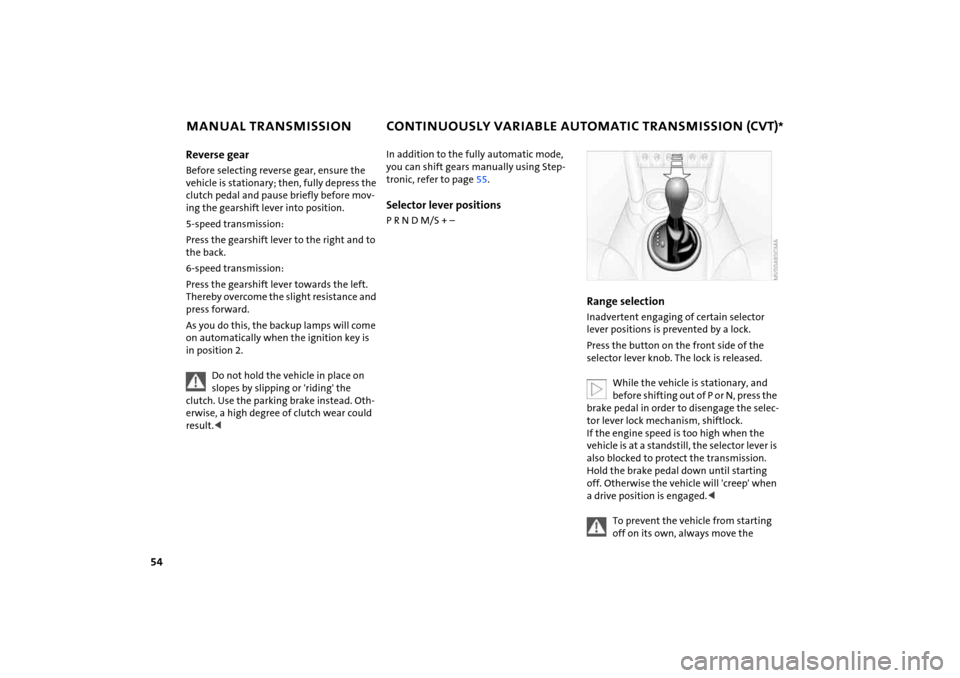
54
MANUAL TRANSMISSION
CONTINUOUSLY VARIABLE AUTOMATIC TRANSMISSION (CVT)
*
Reverse gearBefore selecting reverse gear, ensure the
vehicle is stationary; then, fully depress the
clutch pedal and pause briefly before mov
-
ing the gearshift lever into position.5-speed transmission: Press the gearshift lever to the right and to
the back.6-speed transmission: Press the gearshift lever towards the left.
Thereby overcome the slight resistance and
press forward.As you do this, the backup lamps will come
on automatically when the ignition key is
in position
2.
Do not hold the vehicle in place on slopes by slipping or 'riding' the
clutch. Use the parking brake instead. Oth
-
erwise, a high degree of clutch wear could
result.<
In addition to the fully automatic mode,
you can shift gears manually using Step
-
tronic, refer to page
55.
Selector lever positionsP R N D M/S
+ –
Range selection Inadvertent engaging of certain selector
lever positions is prevented by a lock.Press the button on the front side of the
selector lever knob. The lock is released.
While the vehicle is stationary, and before shifting out of P or N, press the
brake pedal in order to disengage the selec
-
tor lever lock mechanism, shiftlock.
If the engine speed is too high when the
vehicle is at a standstill, the selector lever is
also blocked to protect the transmission.
Hold the brake pedal down until starting
off. Otherwise the vehicle will 'creep' when
a drive position is engaged.<
To prevent the vehicle from starting off on its own, always move the
Page 59 of 165

57
OVERVIEW REPAIRS OPERATIONCONTROLS DATA INDEX
PARKING LAMPS/LOW BEAMS Switching on the parking lamps Turn to the first position.
The front, rear and side vehicle lighting is
switched on.
Standing lamps on one side, refer to next
column.Switching on the low beamsTurn to the second position.
With the low beams on and with the igni
-
tion switched off, only the parking lamps
will remain on.
'Follow me home' lampsIf you activate the headlamp flasher after
having switched off the engine and the
lights, the low beams will stay lit for a pre
-
set period of time.
You can have this function pro
-
grammed.<
Switching on the standing lamps For parking, you can activate lights on one
side of the vehicle. Observe local laws.In ignition key position
0:
Move the lever to the adequate turn signal
indicator position.
The standing lamps discharge the battery. Avoid using them for longer
periods of time; otherwise, you may not be
able to start the engine.<
'Lights on' warning If the lights have not been switched off and
the ignition key is in position
0, an acoustic
signal sounds for a few seconds when you
open the driver's door to remind you that
the lights have not been switched off.
Daytime driving lamps* If convenient, the light switch can be left in
position
0 or 1.
The low beams switch on automatically in
ignition key position 2 or higher.
The exterior lamps go out when the igni
-
tion is switched off and the light switch is
set to position 0. In position 1, the parking
lamps are automatically switched on.
The dynamic headlamp range con
-
trol for xenon lamps only operates
with the light switch in position
1 or 2.<
You can have the daytime driving lamp function activated/deacti
-
vated.<
Page 62 of 165
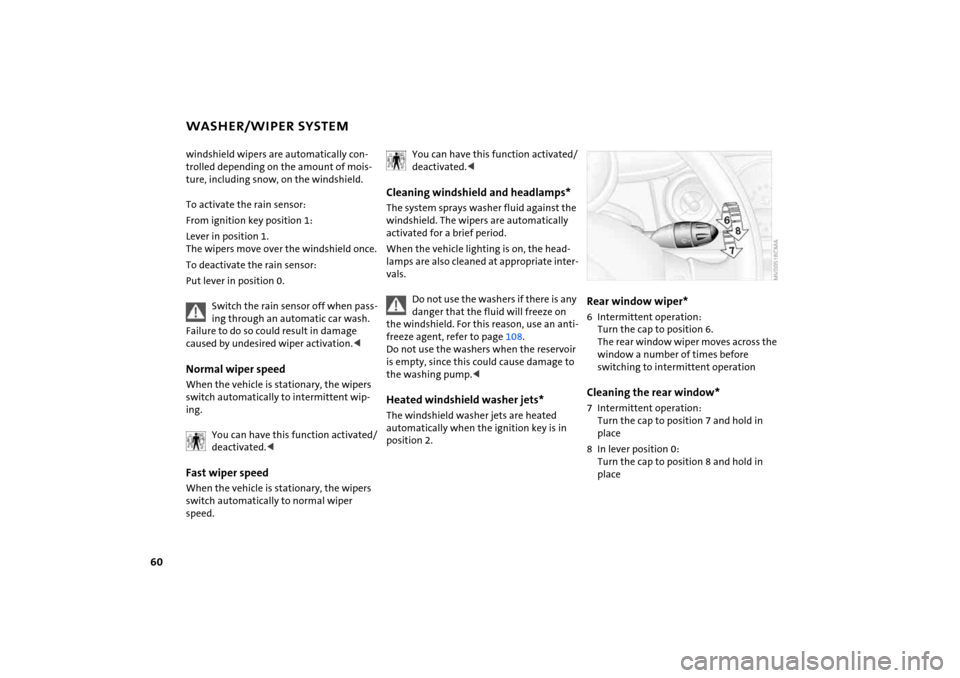
60
WASHER/WIPER SYSTEMwindshield wipers are automatically con
-
trolled depending on the amount of mois
-
ture, including snow, on the windshield. To activate the rain sensor:From ignition key position
1:
Lever in position 1.
The wipers move over the windshield once.To deactivate the rain sensor:Put lever in position
0.
Switch the rain sensor off when pass
-
ing through an automatic car wash.
Failure to do so could result in damage
caused by undesired wiper activation. <
Normal wiper speedWhen the vehicle is stationary, the wipers
switch automatically to intermittent wip
-
ing.
You can have this function activated/deactivated.<
Fast wiper speedWhen the vehicle is stationary, the wipers
switch automatically to normal wiper
speed.
You can have this function activated/deactivated. <
Cleaning windshield and headlamps * The system sprays washer fluid against the
windshield. The wipers are automatically
activated for a brief period.When the vehicle lighting is on, the head
-
lamps are also cleaned at appropriate inter
-
vals.
Do not use the washers if there is any danger that the fluid will freeze on
the windshield. For this reason, use an anti
-
freeze agent, refer to page
108
.
Do not use the washers when the reservoir
is empty, since this could cause damage to
the washing pump.
position
2.
Rear window wiper * 6 Intermittent operation:
Turn the cap to position
6.
The rear window wiper moves across the
window a number of times before
switching to interm ittent operationCleaning the rear window * 7 Intermittent operation:
Turn the cap to position
7 and hold in
place
8 In lever position
0:
Turn the cap to position
8 and hold in
place